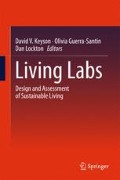Abstract
In this chapter several aspects in the design of home energy feedback are discussed along with the presentation of energy feedback design examples. The examples include the Ampul interface that was tested in the SusLab Concept House. Ampul was designed to enable users to maximize the use of available solar energy. A second example referenced is an aquarium metaphor in which plant, water and fish qualities are coupled to energy consumption and climate sensor data, which was developed as a demonstration and thirdly Powercord is described as an interface able to translate energy consumption into auditory sounds.
Access this chapter
Tax calculation will be finalised at checkout
Purchases are for personal use only
References
Chapa, J. (2007). THE ENERGY ORB: Visualize Electricity Consumption! Retrieved September 1 2007, from inhabitat.com.
Dietz, T, Gardner, G. T., Gilligan, J., Stern, P.C., & Vandenbergh M. P. (2009). Proceedings of the National Academy of Sciences USA, 106(44), 18452–18456 (2009). doi:10.1073/pnas.0908738106.
Do, E. Y., & Abdelmohsen, S. (2008). Energy puppet: An ambient awareness interface for home, energy consumption. In 7th International Workshop on Social Intelligence Design, Designing socially aware interactions, SID 08, December 3–5, 2008 Universidad de Puerto Rico, San Juan, PR
Eichhammer, W., Fleiter, T., Schlomann, B., Faberi, S., Fioretto, M., Piccioni, N., et al. (2009). Study on the energy savings potentials in EU member states, candidate countries and EEA countries.
Ellis, M., & Jolland, N. (2009). Gadgets and gigawatts, policies for energy efficient electronics. Paris: International Energy Agency.
Geelen, D., Reinders, A., & Keyson, D. (2013). Empowering the end-user in smart grids: Recommendations for the design of products and services. Energy Policy, 61, 151–161.
Guerra Santin, O., & Itlard, L. (2010). Occupants’ behavior determinants and effects on residential heating consumption. Building Research and Information, 38, 318–338.
Horvitz, E. (1999). Principles of mixed-initiative user interfaces. In Proceedings of the SIGCHI conference on human factors in computing systems (pp. 159–166).
Keyson, D. V. (2008). The experience of intelligent products in product experience. In Schifferstein & Hekkert (Eds.), Elsevier Science.
Keyson, D. V., Al Mahmud, A. Romero, N., & Augusto J. C., et al. (Eds.): Living Lab and research on sustainability: Practical approaches on sustainable interaction design. AmI 2013, LNCS 8309, 229–234, 2013. Springer International Publishing Switzerland 2013.
Lutzenhiser, L. (1993). Social and behavioral aspects of energy use. Annual Review of Energy and the Environment, 18, 247–289.
Sanquist, T. F., Orr, H., Shui, B., & Bittner, A. C. (2012). Lifestyle factors in U.S. residential electricity consumption. Energy Policy, 42, 354–364.
Savvaki, K. (2015). Sustainability and comfort in the workplace. Master Thesis, Delft University of Technology.
Sorrell, S. (2007). The rebound effect: An assessment of the evidence for economy-wide energy savings from improved energy efficiency. UK Energy Research Centre.
Wattson display. (http://www.treehugger.com/clean-technology/wattson-monitor-your-homes-energy-usage.html).
Author information
Authors and Affiliations
Corresponding author
Editor information
Editors and Affiliations
Rights and permissions
Copyright information
© 2017 Springer International Publishing Switzerland
About this chapter
Cite this chapter
Keyson, D.V., Romero Herrera, N. (2017). Making Energy Feedback Understandable. In: Keyson, D., Guerra-Santin, O., Lockton, D. (eds) Living Labs. Springer, Cham. https://doi.org/10.1007/978-3-319-33527-8_22
Download citation
DOI: https://doi.org/10.1007/978-3-319-33527-8_22
Published:
Publisher Name: Springer, Cham
Print ISBN: 978-3-319-33526-1
Online ISBN: 978-3-319-33527-8
eBook Packages: EngineeringEngineering (R0)

